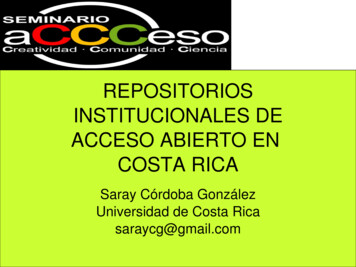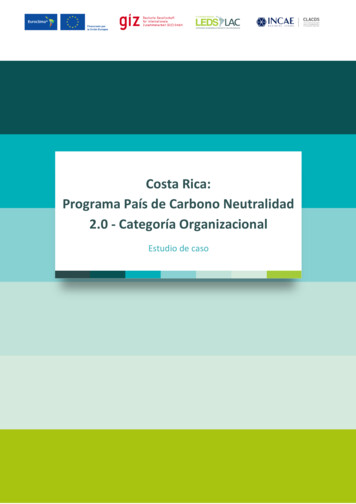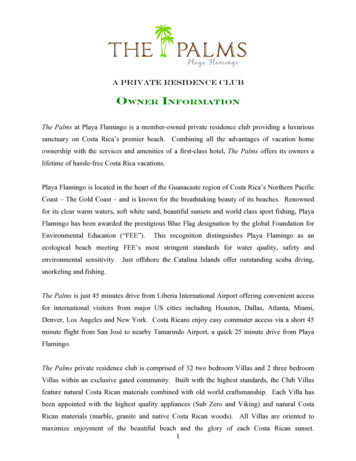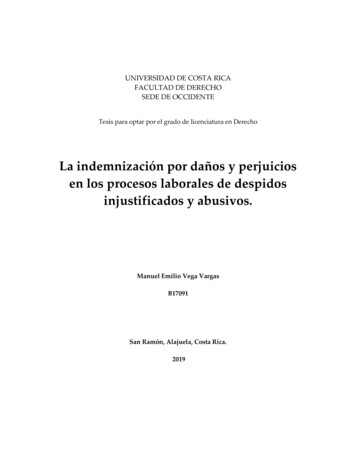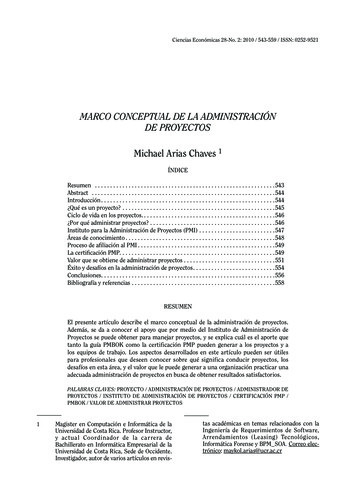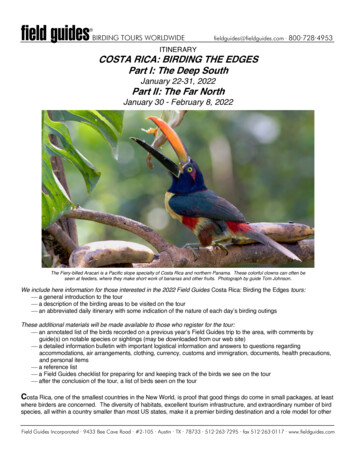
Transcription
field guides BIRDING TOURS WORLDWIDEfieldguides@fieldguides.com 800 728 4953ITINERARYCOSTA RICA: BIRDING THE EDGESPart I: The Deep SouthJanuary 22-31, 2022Part II: The Far NorthJanuary 30 - February 8, 2022The Fiery-billed Aracari is a Pacific slope specialty of Costa Rica and northern Panama. These colorful clowns can often beseen at feeders, where they make short work of bananas and other fruits. Photograph by guide Tom Johnson.We include here information for those interested in the 2022 Field Guides Costa Rica: Birding the Edges tours:¾ a general introduction to the tour¾ a description of the birding areas to be visited on the tour¾ an abbreviated daily itinerary with some indication of the nature of each day’s birding outingsThese additional materials will be made available to those who register for the tour:¾ an annotated list of the birds recorded on a previous year’s Field Guides trip to the area, with comments byguide(s) on notable species or sightings (may be downloaded from our web site)¾ a detailed information bulletin with important logistical information and answers to questions regardingaccommodations, air arrangements, clothing, currency, customs and immigration, documents, health precautions,and personal items¾ a reference list¾ a Field Guides checklist for preparing for and keeping track of the birds we see on the tour¾ after the conclusion of the tour, a list of birds seen on the tourCosta Rica, one of the smallest countries in the New World, is proof that good things do come in small packages, at leastwhere birders are concerned. The diversity of habitats, excellent tourism infrastructure, and extraordinary number of birdspecies, all within a country smaller than most US states, make it a premier birding destination and a role model for otherField Guides Incorporated 9433 Bee Cave Road #2-105 Austin TX 78733 512 263 7295 fax 512 263 0117 www.fieldguides.com
2developing countries that would like to enhance their images as ecotourism destinations. The only problem is, there areso many great places to go that it’s pretty much impossible to visit them all in a single trip. With that in mind, we’vedesigned these two tours to complement our long-running, classic COSTA RICA tour, visiting some areas and targetingsome birds that we just don’t get to on the “classic.”Part I takes us south of the capital city of San Jose, along the spine of the Talamanca Mountains, and down to nearthe Panamanian border, where we’ll track down a bunch of species that occur nowhere other than in Costa Rica and itsneighbor to the south. We’ll break up the long drive south with some birding in the montane forests and paramos of Cerrode la Muerte (where a host of Chiriqui highland endemics may be found, including a slim chance of the breathtakingResplendent Quetzal) and a two-night stay in San Isidro, with a visit to Los Cusingos, former home of the late, greatnaturalist Alexander Skutch, author of the original (and still unsurpassed) field guide to Costa Rica’s birds. Here we’llenjoy some of the species that were the subjects of Skutch’s many writings on tropical birdlife, perhaps including theshowy Fiery-billed Aracaris for which the site is named, or even the dazzling Turquoise Cotinga, before arriving at ourprimary destinations near the border.Once we’ve arrived in the deep south, we’ll be dividing our time between two main sites, each with a very different mixof birds. Starting in the mountains, we’ll base ourselves at the beautiful Wilson Botanical Gardens near San Vito. Thegardens and surrounding areas are home to a good variety of mid-elevation species, including a number of southernspecialties. Hummingbirds are well-represented here, with White-tailed and Garden emeralds, Snowy-bellied andCharming hummingbirds, and White-crested Coquette all among the possibilites. Other specialties of the south that wecould encounter here include the elusive Ruddy Foliage-gleaner, the newly-split Chiriqui Foliage-gleaner, Baird’s Trogon,and Costa Rican Brushfinch, in addition to a wonderful assortment of more widely-occurring species. Marshes andgrasslands in the region can be good for such things as Bran-colored Flycatcher, Pale-breasted Spinetail, and the localrace of Olive-crowned Yellowthroat, which is sometimes treated as a separate species, Chiriqui Yellowthroat.Our second southern destination is in the lowlands near the Pacific coast, at the fantastic Esquinas Rainforest Lodge.The area’s star bird is the beautiful Black-cheeked Ant-Tanager, endemic to this small corner of Costa Rica and a regularvisitor to the grounds of the lodge. Among other regional specialties to be found here are Golden-naped Woodpecker,Black-hooded Antshrike, the immaculate Yellow-billed Cotinga, and snappy Orange-collared Manakins. In recent years, anumber of species new to the Costa Rica list have been found in this region, including Brown-throated Parakeet,Veraguan Mango, Sapphire-throated Hummingbird, and Crested Oropendola, and we’ll make an effort to find some ofthese recent arrivals as well. Our return to San Jose will take us up along the coast and offers a chance of more newspecies, including the possibility of showy Scarlet Macaws in the Carara region.The charismatic Zeledonia, or Wrenthrush, is a near-endemic that we will seek on Part I. These ground dwellers are found inbamboo thickets and other dense stands of vegetation in the higher elevations of Costa Rica and western Panama.Photograph by guide Tom Johnson.Field Guides Incorporated 800 728 4953 fieldguides@fieldguides.com
3Part 2 begins where Part 1 ends, at our excellent hotel near San Jose, from where we will head northward towardsNicaragua. We’ll begin with a visit to Poas Volcano National Park and the La Paz Waterfall Gardens for some greathighland birding and a mind-boggling array of hummingbirds to start things with a bang (or a buzz, really!). We could endthe first day of birding with close to 15 species of hummingbirds including massive Violet Sabrewings and the diminutiveendemic Coppery-headed Emerald, as well as a fine assortment of other mid to high elevation birds from Prong-billedBarbet to Northern Emerald-Toucanet to Sooty-faced Finch. We’ll continue our exploration of the bird-rich middleelevations during a 2-night stay at the wonderful, secluded, Bosque de Paz. The lush cloudforests here abound withbirds, with a good selection of Furnariids including Red-faced Spinetail, Spotted Barbtail, Streak-breasted Treehunter,Lineated Foliage-gleaner, and Tawny-throated Leaftosser, plus a number of Chiriqui endemics like Black Guan (probablythe best site for them), the elusive Silvery-fronted Tapaculo, Yellow-thighed Brushfinch, and Golden-browedChlorophonia. Feeders at the lodge attract in a variety of birds, as well as mammals such as White-nosed Coatis, and,after dark, the rarely-seen Paca, an agouti-like large rodent with white spots.Next up is a three-night stay at the foot of what was once Costa Rica’s most active volcano, Arenal. The Caribbeanfoothill forests here support a superb array of birdlife with groups like hummingbirds, antbirds, and tanagers all wellrepresented. From these three groups alone we hope to track down gems like Black-crested Coquette and Violet-headedHummingbird, Ocellated, Spotted, and Bare-crowned antbirds, and Rufous-winged and Emerald tanagers. The Arenalregion is also the best place in Costa Rica (and perhaps anywhere) to see the very local Keel-billed Motmot, while GreatCurassow, Ornate Hawk-Eagle, Lovely Cotinga, White-ruffed Manakin, White-throated Magpie-Jay, and Song Wren arejust a few of the many other enticing possibilities to be searched for here. And while the volcano is no longer reliable forthe once regular light and sound shows, the perfect volcanic cone provides a stunning backdrop for birding in this richregion.The Keel-billed Motmot has a limited distribution in central America, with Costa Rica at the far southern end. We’ll look for thislovely bird at Volcan Arenal on Part II of the tour. Photograph by guide Tom Johnson.We finish up our northern sojourn at the vast wetlands of Cano Negro in the far north. Located in the Lake Nicaragualowlands, the Cano Negro region has a unique mix of birds, primarily Caribbean slope species, but with several typicallyPacific slope birds and some northern Central American species found nowhere else in the country. Boat trips throughthe extensive wetlands system should turn up a tremendous variety of wetland birds including Sungrebe, Russet-napedWood-Rail, and American Pygmy-Kingfisher, and with luck, a rarity or two in the form of Pinnated Bittern, Yellow-breastedCrake, or Agami Heron. The boat trip also offers us our best chance at the very local Nicaraguan Grackle, found only inthe Lake Nicaragua lowlands. Forests and grasslands adjacent to the wetlands offer up local specialties like Gray-headedDove, Spot-breasted Wren, and Nicaragaun Seed-Finch, and nocturnal birding can be productive too, with both Commonand Great potoos, Pacific Screech-Owl, and Black-and-white and Striped owls among the possibilities.Field Guides Incorporated 800 728 4953 fieldguides@fieldguides.com
4Whether you’ve already done our “classic” COSTA RICA tour and want to come back for more or this is your firstvisit to this tropical paradise, these two tours are sure to provide you with an unforgettable experience and an impressivelist of fabulous tropical birds. Come join us for a winter getaway (short or long) and see for yourself why Costa Rica isamong the top birding destinations in the Americas!All participants will be required to confirm they will have completed a full COVID vaccination course at least twoweeks prior to the tour (if you are getting a two-dose vaccine, this means you must receive your second dose two weeksprior to departure). Having a vaccinated group will greatly diminish but not eliminate the possibility of the group andindividual participants being adversely affected by COVID-19. We are requiring all of our staff guides to bevaccinated. Note too that many travel destinations are or soon will be requiring proof of vaccination for entry to bypasstesting delays or quarantine, and that entry requirements for a destination can change at any time.We want to be sure you are on the right tour! Below is a description of the physical requirements of the tour. If you areconcerned about the difficulty, please contact us about this and be sure to fully explain your concerns. We want to makesure you have a wonderful time with us, so if you are uncomfortable with the requirements, just let us know and we canhelp you find a better fitting tour! Field Guides will not charge you a change or cancellation fee if you opt out within 10days of depositing.Physical requirements of this tour TRAILS & WALKING: Moderate amounts of walking, up to 2-3 miles in morning, 1-2 miles in afternoon, often ontrails that have slippery, steep, and/or rocky sections. Walking sticks and/or folding stools recommended for thosewho use them.PACE: Early morning starts, usually with 5:00-5:30 a.m. breakfast. On some days, we will bird through the daywith a picnic lunch. On other days, there will be an after-lunch break before an optional afternoon birding session.On some days, we will travel by vehicle to the next destination in the afternoon. There will be a couple of optionalnighttime excursions to look for birds; we will usually return to the hotel by 10:00 p.m.WEATHER: Weather in Costa Rica varies dramatically depending on the location and elevation. We can expecttemps in the 40s at higher elevations to the 90s in the lower elevations. Periods of rain can also be expected.ELEVATION: Sea level to 10,500 feet; lodges are all below 4800 feet.VEHICLE SEATING: So that each participant has equal opportunity during our travel, we employ a seat rotationsystem on all tours. Participants will need to be flexible enough to maneuver to the back of the vehicle onoccasion. Those who experience motion sickness will need to bring adequate medication for the duration of thetour, as we are not able to reserve forward seats for medical conditions.BATHROOM BREAKS: Whenever possible, we use modern, indoor restrooms, but on occasion, participantsmust be prepared to make a comfort stop in nature.OPTING OUT: Where we are staying multiple days in the same lodging, participants can easily opt to sit out a dayor sometimes a half-day. This will not be possible on days when we are changing locations.Other considerations: The majority of our birding will be along forest trails, where a good number of shy, skulkingspecies may take considerable effort to see well (if we see them at all). Taped recordings can make it easier to see manyspecies, and we do use tapes sensitively to lure birds into view. Since we try to show these birds to all participants beforethey disappear, patience and courtesy to your fellow birders is important in these situations, and good listening skills areimportant as the guides give directions to the birds. The guides, when possible, will attempt to find these species again,but invariably everyone will miss seeing a few birds. Before the tour, adequate preparation with a Costa Rican field guide,your field checklist, and the tour itinerary is always an asset, allowing you to associate an image with the name your guidecalls out in the field. Knowing what you’re looking for can make finding it just a little bit easier.If you are uncertain about whether this tour is a good match for your abilities, please don’t hesitate to contact ouroffice; if they cannot directly answer your queries, they will put you in touch with the guide.About the Birding AreasPart ICerro de la Muerte, the “mountain of death”, is the highest point along the Costa Rican stretch of the Inter-Americanhighway. Located south of San Jose, in the Talamanca mountain range, the road passes through some excellent areas ofmontane forest and paramo habitat, home to a large number of species (collectively called Chiriqui endemics) that areField Guides Incorporated 800 728 4953 fieldguides@fieldguides.com
5found only in the mountains of Costa Rica and neighboring Panama. We’ll spend our initial travel day making severalstrategic stops along the route in an attempt to see as many of these highland specialties as possible. The magnificent,towering oak forests below the paramo zone are home to many species, including the stunning Resplendent Quetzal, andwe’ll certainly be on the look out for them although they’ve been tougher in recent years. The quetzal is often describedas the most beautiful bird in the world, but there are plenty of other local contenders vying for the title, and we’ll also besearching for Fiery-throated Hummingbird, Northern Emerald-Toucanet, Buffy Tuftedcheek, Barred Becard, Yellowwinged Vireo, the ethereal-sounding Black-faced Solitaire, Long-tailed Silky-Flycatcher, fiery Flame-throated Warblers,Black-cheeked Warbler, the delightful Collared Redstart, Wrenthrush (an enigmatic and unusual warbler), Spanglecheeked Tanager, Large-footed and Yellow-thighed brushfinches, and Black-thighed Grosbeak among many others.Farther up in the paramo zone, the tiny Volcano Hummingbird, Sooty Thrush, Black-billed Nightingale-Thrush, excitableTimberline Wrens, Sooty-capped Chlorospingus, Volcano Junco, and the rare Peg-billed Finch will be among our mainquarry.Los Cusingos Bird Sanctuary is a small 190acre forest reserve not far from the southern cityof San Isidro de El General. Dr. AlexanderSkutch, author of the original Costa Rica fieldguide and numerous works on Neotropical birds,bought the land in 1941, and lived here until hisdeath in 2004, just a few days before his 100thbirthday. In 1993, the Tropical Science Centertook over management of the reserve and theycontinue to manage the land as a sanctuary. Thereserve will give us our first taste of somesouthern Costa Rica specialties, including Fierybilled Aracari (for which the reserve is named),Baird’s Trogon, Charming Hummingbird,Olivaceous Piculet, the striking Riverside Wren,Streaked Saltator, Spot-crowned Euphonia, andScarlet-rumped (Cherrie’s) Tanager. Rare butregular species we hope to encounter here or inthe surrounding area include the diminutiveWhite-crested Coquette, Orange-collaredManakin, the shimmering blue Turquoise Cotinga,and Costa Rican Brushfinch, recently elevated toa full species. Gray-headed Chachalaca, Gray-cowled Wood-Rail, Pale-billed Woodpecker, Laughing Falcon, Whitecrowned Parrot, Tawny-winged Woodcreeper, Dot-winged Antwren, Golden-crowned Spadebill, Bright-rumped Attila,Red-capped Manakin, Speckled and Golden-hooded tanagers, Green Honeycreeper, and Blue-black Grosbeak areamong the many more widespread possibilities here.Wilson Botanical Gardens, founded in 1962 as a botanical center and nursery, is part of the Las Cruces BiologicalStation, one of several such stations operated by the Organization for Tropical Studies. Situated at 1200m (3900 feet)above sea level, the gardens and surrounding station protect 740 acres of Premontane Wet Forest, about two-thirds ofwhich are primary forest. Trails allow good access to the gardens and forest, and our time here will be spent exploringthese trails for birds like Little Tinamou, Marbled Wood-Quail, Blue-headed and Brown-hooded parrots, Snowy-belliedHummingbird and White-tailed Emerald, both of which are restricted to Costa Rica and Panama, Lesson’s Motmot,Rufous-tailed Jacamar, Red-crowned and Rufous-winged woodpeckers, Chiriqui and Ruddy foliage-gleaners, theincredible Brown-billed Scythebill, Plain Antvireo, Scale-crested Pygmy-Tyrant, White-crowned Spadebill, White-ruffedand Blue-crowned manakins, Orange-billed Nightingale-Thrush, Rufous-breasted Wren, Buff-rumped Warbler, Silverthroated and Bay-headed tanagers, Scarlet-thighed Dacnis, Spot-crowned Euphonia and many more. In the surroundingmarshes and grasslands, White-throated Crake, the beautiful Scaled Pigeon, Pale-breasted Spinetail, Lesser Elaenia,Bran-colored Flycatcher, the elegant Fork-tailed Flycatcher, Olive-crowned (Chiriqui) Yellowthroat, and CrestedOropendola will be among our targets. Night birding around the station may produce Mottled Owl.Esquinas Rainforest Lodge is tucked into a corner of Piedras Blancas National Park, a huge area (34,000 acres) ofevergreen primary forest situated on the south Pacific coast. The lodge is part of a project combining conservation,research, and community development, and is a model of sustainable development, working to protect the local forestsField Guides Incorporated 800 728 4953 fieldguides@fieldguides.com
6while providing jobs for the local population. With the forest at our doorstep, the lodge is a perfect location from which tosearch for the region’s numerous bird species, foremost of which is the endemic Black-cheeked Ant-Tanager, which canoften be found on the grounds of the lodge itself. Other species to be looked for here include Great Curassow, KingVulture, White Hawk, Band-tailed Barbthroat, Charming Hummingbird, Blue-throated Goldentail, Spectacled Owl, Baird’sTrogon, White-necked and White-whiskered puffbirds, Golden-naped Woodpecker, Black-hooded Antshrike, Chestnutbacked and Bicolored antbirds, Black-faced Antthrush, Long-tailed and Black-striped woodcreepers, Northern Bentbill,Ruddy-tailed and Sulphur-rumped flycatchers, Rufous Piha, Green Shrike-Vireo, Black-bellied Wren, Gray-headedTanager, White-throated Shrike-Tanager, Red-legged Honeycreeper, and Orange-billed Sparrow. In surrounding areaswe’ll search for local specialties like Red-rumped Woodpecker, Yellow-billed and Turquoise cotingas, Scrub Greenlet, andRuddy-breasted and Slate-colored seedeaters, and, with luck, some recent arrivals from Panama including VeraguanMango, Sapphire-throated Hummingbird, Brown-throated Parakeet, and Rusty-margined Flycatcher.The Coppery-headed Emerald is a Costa Rican endemic. We’ll find this little gem in the highlands of the north.Photograph by guide Tom Johnson.Part IIPoas Volcano National Park, Costa Rica’s first national park, is also one of the most popular. Located just a short drivefrom San Jose, the park’s centerpiece is the spectacular crater lake in the main caldera, but for birders, it’s the large areasof temperate cloud forest around the caldera that are the main attraction. Many of the Chiriqui highland endemics arepossible here, including Fiery-throated and Volcano hummingbirds, Ruddy Treerunner, Black-capped Flycatcher, Longtailed and Black-and-Yellow silky-flycatchers, Black-billed Nightingale-Thrush, Yellow-winged Vireo, Black-cheeked andFlame-throated warblers, Collared Redstart, and Large-footed Finch.La Paz Waterfall Garden is a privately owned ecological reserve situated between 4000 and 5000 feet in elevation on theslopes of Poas Volcano. The lush and wet cloudforest here is rich with birds, and hummingbirds in particular arenumerous, with a dozen or more species swarming around the hummingbird feeders. Regulars here include the endemicCoppery-headed Emerald, Black-bellied Hummingbird, Green Thorntail, and the always impressive Violet Sabrewing.Apart from hummingbirds, the surrounding forests harbor Barred Hawk, Black Hawk-Eagle, Prong-billed and Red-headedbarbets, Golden-bellied Flycatcher, Barred Becard, Ochraceous Wren, Spangle-cheeked and Silver-throated tanagers,Chestnut-capped Brushfinch, and Sooty-faced Finch, to name but a few.Bosque de Paz is a charming and secluded lodge tucked into a region of spectacular cloudforest that forms part of abiological corridor between the montane forests of Poas Volcano and the lower elevation forests of the remote andinaccessible Juan Castro Blanco National Park. At 4700 feet in elevation, the lodge is in very similar forest to that of LaField Guides Incorporated 800 728 4953 fieldguides@fieldguides.com
7Paz Waterfall Gardens, the big difference being that here we have the forest pretty much to ourselves! Some of the keybirds of the area are Black Guan (arguably the best place anywhere to see this handsome bird), Bicolored Hawk, GreatBlack-Hawk, Scintillant Hummingbird, Resplendent Quetzal (sometimes near the lodge), Dark Pewee, Tufted Flycatcher,Silvery-fronted Tapaculo, Ruddy-capped and Slaty-backed nightingale-thrushes, Costa Rican Warbler, Yellow-thighedBrushfinch, and an incredible assortment of Furnariids including Black-banded Woodcreeper, Brown-billed Scythebill,Lineated Foliage-Gleaner, Spotted Barbtail, Red-faced Spinetail, and Streak-breasted Treehunter. This can also be aproductive site for mammals with agoutis and coatis being regular visitors to corn meal feeders near the lodge, with theshy and elusive Paca (a large white-spotted rodent) often turning up after dark.We will visit Bosque de Paz on Part II of the tour. This may be our best place to find the wonderful Resplendent Quetzal.This female may not be quite as spectacular as the male, but she is stunningly beautiful in her own way.Photograph by guide Cory Gregory.Arenal region—Until a few years ago, Arenal Volcano was the country’s most active volcano, and one of the top 10 mostactive in the world. Though the activity has abated, and volcanic eruptions are no longer a daily occurrence as they oncewere, the perfectly formed volcanic cone is still a breathtaking sight and well worth the visit to this region. Better still, thevolcano, part of the Tilaran mountain chain, sits amidst a blanket of protected primary forest and the bird life in the regionis prolific. Here in the Caribbean foothill forest we’ll search for Great Curassow, Crested Guan, White Hawk, OrnateHawk-Eagle, Black-crested Coquette, the rare and local Keel-billed Motmot, Smoky-brown Woodpecker, Streak-crownedAntvireo, Ocellated, Spotted, Zeledon’s, Bare-crowned, and Dull-mantled antbirds, Thicket Antpitta (vocal but sneaky),White-ruffed and Red-capped manakins, White-throated Magpie-Jay (a spillover from the Pacific slope), Black-throated,Stripe-breasted, Nightingale, and Song wrens, White-throated Shrike-Tanager, and Emerald, Speckled, and Rufouswinged tanagers, among so many more.Cano Negro Wildlife Refuge is a large wetland area in Costa Rica’s far north, in the lowlands around Lake Nicaragua.Though the refuge is on the Caribbean slope of the country, the climatic influence of the dry North Pacific region gives thisarea a distinct wet and dry season, unlike the rest of the Caribbean side. In the wet season, the Rio Frio, on its way toLake Nicaragua, overflows its banks, flooding the area and turning it into one big shallow lake. In the dry season, thewaters recede, concentrating birds and other wildlife around the pools, lagoons, and channels that remain. A great varietyof migrant and resident waterbirds gather here in the winter, and our boat trips through the wetlands should yield a goodselection of the following species: Black-bellied Whistling-Duck, Wood Stork, Jabiru (rare), Anhinga, Pinnated Bittern,Bare-throated Tiger-Heron, Agami Heron (rare), the bizarre Boat-billed Heron, Green, White, and Glossy ibises, Blackcollared Hawk, Snail Kite, Sungrebe, Russet-naped Wood-Rail, the elusive Yellow-breasted Crake, and all 6 species ofField Guides Incorporated 800 728 4953 fieldguides@fieldguides.com
8New World kingfishers, with the tiny American Pygmy being a regular. The very local Nicaraguan Grackle can also befound here, the only reliable site for it in the country. Aside from wetland birds, the region is home to a good mix ofspecies, the majority of which are birds of the Caribbean lowlands, though there are a few typical Pacific slope species tobe found as well. Among the birds we’ll search for here are Lesser Yellow-headed Vulture, Gray-headed Dove, Plainbreasted Ground-Dove, Scaly-breasted Hummingbird, Black-headed Trogon, Olivaceous Piculet, Bat Falcon, Olivethroated and Orange-chinned parakeets, Barred Antshrike, Slaty Spinetail, Slate-headed Tody-Flycatcher, NorthernBeardless-Tyrannulet, Spot-breasted Wren, Ruddy-breasted Seedeater, and Nicaraguan Seed-Finch.The exquisite Turquoise Cotinga is just one example of the amazing birds of Costa Rica.Photograph by guide Tom Johnson.Itinerary for Costa Rica: Birding the EdgesFor more detailed information on the birds to be found at each site, please refer to the above section on the birding areas.Part I: The Deep SouthDay 1, Sat, 22 Jan. Arrival. There are many daily flights into San Jose from various North American cities; call our officeand we’ll be happy to help you determine the flight schedule that best suits your needs. As you exit the custom’s area atthe San Jose airport (after going through customs and immigration, of course!), you will come to a wall of large glasswindows with people waiting on the other side. If you’re arriving on the first day of the tour or if you’re arriving early andhave a private transfer arranged, look for the Costa Rica Gateway driver holding a sign up with “Field Guides” and/or yourname on it. It’s easier to spot this person from behind the glass wall, where it’s less crowded. Once you connect with thedriver and head out into the public area, he or she will help you with your luggage and take you to the hotel. If you fail tofind the representative, please arrange for a taxi to take you to the Hotel Bougainvillea (approximately 35US). We’ll planto meet at 4:30 p.m. for a walk around the back gardens and then in the hotel lobby at 7:00 p.m. for dinner. Night at HotelBougainvillea.Day 2, Sun, 23 Jan. To Cerro de la Muerte and San Isidro. After an early breakfast at the hotel, we’ll load up the busand start out on our drive south towards the Panama border. Our drive will take us along the spine of the Talamancamountains and to the highest point on the CR section of the Inter-American highway, where we’ll be passing throughsome beautiful montane habitat. We’ll spend the morning birding at several strategic stops along the route, looking for abunch of highland specialties, which could include Fiery-throated Hummingbird, Long-tailed Silky-Flycatcher, Flamethroated Warbler, and a slim chance for the incomparable Resplendent Quetzal. After lunch we’ll continue southwardsand expect to arrive at our hotel near San Isidro in time for some birding on the hotel grounds (with Riverside Wren andField Guides Incorporated 800 728 4953 fieldguides@fieldguides.com
9Costa Rican Brushfinch among the possibilities) or a dip in the pool if you prefer. Temperatures in the mountains arelikely to be the coolest on the tour, and you should have a sweater and/or jacket handy in your day pack, alongwith your rain gear in case of inclement weather. Night at Talari Mountain Lodge.Day 3, Mon, 24 Jan. Los Cusingos. After some early morning birding around the lodge, we’ll make our way the shortdistance to the Los Cusingos Bird Sanctuary where we’ll make the acquaintance of a number of birds that were thesubjects of Alexander Skutch’s insightful writings. We’ll spend a good part of the day here in search of manakins(Orange-collared, Blue-crowned, Red-capped), tanagers such as Scarlet-rumped (Cherrie’s) and Speckled, andnumerous other species, with a decent chance at the stunning Turquoise Cotinga as well. After lunch back at the lodge,we’ll either make a return to continue birding the reserve’s trails, or remain at the lodge for some more afternoon birdingthere, depending on our needs. Night at Talari Mountain Lodge.This handsome Chestnut-backed Antbird was seen on the grounds of Los Cusingos on a recent Field Guides tour. The colorband it wears is evidence of ongoing research into the lives of birds in the tropics. Photograph by guide Cory Gregory.Day 4, Tue, 25 Jan. To Wilson Botanical Gardens. After some morning birding around the lodge, we’ll board the busand continue working our way southward, with the aim of arriving in San Vito by early afternoon. We’ll spend theremainder of our daylight hours making an initial exploratio
Field Guides Incorporated 9433 Bee Cave Road # 2-105 Austin TX 78733 512 263 7295 fax 512 263 0117 www.fieldguides.com ITINERARY COSTA RICA: BIRDING THE EDGES Part I: The Deep South . and snappy Orange-collared Manakins. In recent years, a number of species new to the Costa Rica list have been found in .



